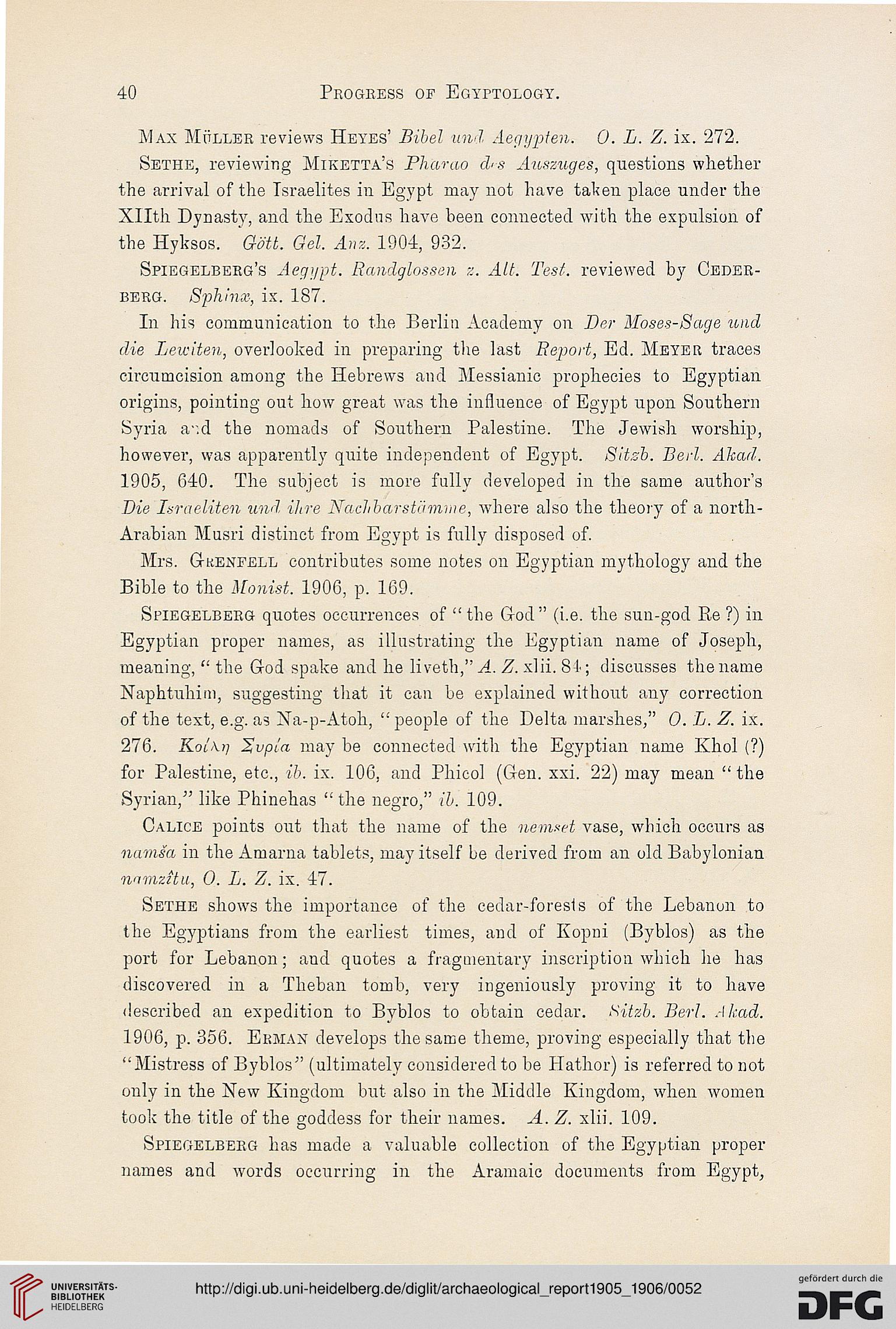40
Progress of Egyptology.
Max Muller reviews Heyes' Bibel und, Aeggpten. 0. L. Z. ix. 272.
Sethe, reviewing Miketta's Pharao d>s Auszuges, questions whether
the arrival of the Israelites in Egypt may not have tal<en place under the
Xllth Dynasty, and the Exodus have been connected with the expulsion of
the Hyksos. Gott. Gel. Anz. 1904, 932.
Spiegelberg's Aegypt. Randglossen z. Alt. Test, reviewed by Ceder-
berg. Sphinx, ix. 187.
In his communication to the Berlin Academy on Per Moses-Sage und
die Lewiten, overlooked in preparing the last Report, Ed. Meyer traces
circumcision among the Hebrews and Messianic prophecies to Egyptian
origins, pointing out how great was the influence of Egypt upon Southern
Syria a-;d the nomads of Southern Palestine. The Jewish worship,
however, was apparently quite independent of Egypt. Sitzb. Bed. Akad.
1905, 640. The subject is more fully developed in the same author's
Pie Israeliten und, Hire Naclibarstamme, where also the theory of a north-
Arabian Musri distinct from Egypt is fully disposed of.
Mrs. Gkenfell contributes some notes on Egyptian mythology and the
Bible to the Monist. 1906, p. 169.
Spiegelberg quotes occurrences of " the God" (i.e. the sun-god Re ?) in
Egyptian proper names, as illustrating the Egyptian name of Joseph,
meaning, " the God spake and he liveth," A. Z. xlii. 84; discusses the name
Naphtuhim, suggesting that it can be explained without any correction
of the text, e.g. as Na-p-Atoh, "people of the Delta marshes," O. L. Z. ix.
276. Koi\>f Svpia may be connected witli the Egyptian name Khol (?)
for Palestine, etc., ib. ix. 106, and Phicol (Gen. xxi. 22) may mean " the
Syrian," like Phinehas " the negro," ib. 109.
Calice points out that the name of the nemset vase, which occurs as
namsa in the Amarna tablets, may itself be derived from an old Babylonian
namzitu, O. L. Z. ix. 47.
Sethe shows the importance of the cedar-foresls of the Lebanon to
the Egyptians from the earliest times, and of Kopni (Byblos) as the
port for Lebanon; and quotes a fragmentary inscription which he has
discovered in a Theban tomb, very ingeniously proving it to have
described an expedition to Byblos to obtain cedar. Sitzb. Berl. A laid.
1906, p. 356. Eeman develops the same theme, proving especially that the
"Mistress of Byblos" (ultimately considered to be Hathor) is referred to not
only in the New Kingdom but also in the Middle Kingdom, when women
took the title of the goddess for their names. A. Z. xlii. 109.
Spiegelberg has made a valuable collection of the Egyptian proper
names and words occurring in the Aramaic documents from Egypt,
Progress of Egyptology.
Max Muller reviews Heyes' Bibel und, Aeggpten. 0. L. Z. ix. 272.
Sethe, reviewing Miketta's Pharao d>s Auszuges, questions whether
the arrival of the Israelites in Egypt may not have tal<en place under the
Xllth Dynasty, and the Exodus have been connected with the expulsion of
the Hyksos. Gott. Gel. Anz. 1904, 932.
Spiegelberg's Aegypt. Randglossen z. Alt. Test, reviewed by Ceder-
berg. Sphinx, ix. 187.
In his communication to the Berlin Academy on Per Moses-Sage und
die Lewiten, overlooked in preparing the last Report, Ed. Meyer traces
circumcision among the Hebrews and Messianic prophecies to Egyptian
origins, pointing out how great was the influence of Egypt upon Southern
Syria a-;d the nomads of Southern Palestine. The Jewish worship,
however, was apparently quite independent of Egypt. Sitzb. Bed. Akad.
1905, 640. The subject is more fully developed in the same author's
Pie Israeliten und, Hire Naclibarstamme, where also the theory of a north-
Arabian Musri distinct from Egypt is fully disposed of.
Mrs. Gkenfell contributes some notes on Egyptian mythology and the
Bible to the Monist. 1906, p. 169.
Spiegelberg quotes occurrences of " the God" (i.e. the sun-god Re ?) in
Egyptian proper names, as illustrating the Egyptian name of Joseph,
meaning, " the God spake and he liveth," A. Z. xlii. 84; discusses the name
Naphtuhim, suggesting that it can be explained without any correction
of the text, e.g. as Na-p-Atoh, "people of the Delta marshes," O. L. Z. ix.
276. Koi\>f Svpia may be connected witli the Egyptian name Khol (?)
for Palestine, etc., ib. ix. 106, and Phicol (Gen. xxi. 22) may mean " the
Syrian," like Phinehas " the negro," ib. 109.
Calice points out that the name of the nemset vase, which occurs as
namsa in the Amarna tablets, may itself be derived from an old Babylonian
namzitu, O. L. Z. ix. 47.
Sethe shows the importance of the cedar-foresls of the Lebanon to
the Egyptians from the earliest times, and of Kopni (Byblos) as the
port for Lebanon; and quotes a fragmentary inscription which he has
discovered in a Theban tomb, very ingeniously proving it to have
described an expedition to Byblos to obtain cedar. Sitzb. Berl. A laid.
1906, p. 356. Eeman develops the same theme, proving especially that the
"Mistress of Byblos" (ultimately considered to be Hathor) is referred to not
only in the New Kingdom but also in the Middle Kingdom, when women
took the title of the goddess for their names. A. Z. xlii. 109.
Spiegelberg has made a valuable collection of the Egyptian proper
names and words occurring in the Aramaic documents from Egypt,





